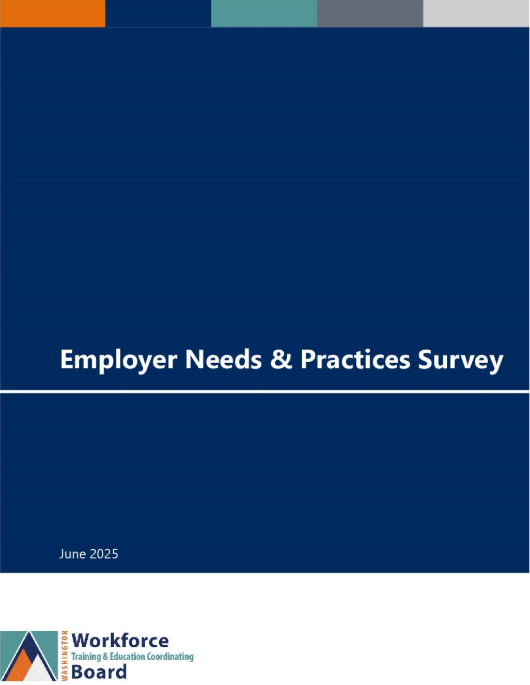Employer Survey
Employers are significant customers of Washington’s workforce development system. The Workforce Board is Washington’s workforce system performance accountability agent, working on behalf of the state’s citizens and employers. Among the Board’s duties spelled out in RCW 28C.18.060 we have that the Board must:
“(10) Every two years administer scientifically based outcome evaluations of the state training system, including, but not limited to, surveys of program participants, surveys of employers of program participants, and matches with employment security department payroll and wage files. Every five years administer scientifically based net-impact and cost-benefit evaluations of the state training system; …”
The Workforce Board conducts the Employer Needs and Practices Survey to obtain information about hiring practices, incumbent worker training, and other necessities of Washington’s employers. The follow-up Employer Satisfaction Survey concerns employer satisfaction with hiring of workforce program participants, as well as the overall satisfaction from engaging with the State’s workforce development system.
Employer Needs and Practices
In the first module of this survey the Workforce Board seeks to assess employer workforce needs and practices. Results are used to assess employer awareness of Washington State’s Workforce System, assess the difficulty Washington employers have in finding qualified applicants, identify successful strategies used to find qualified applicants, identify types of training that employers provide themselves, as well as develop a broader understanding of workforce challenges and concerns. Identifying employer workforce needs and practices is a critical step in employer engagement.
Employer Satisfaction
In the second module, The Satisfaction Survey, the Workforce Board collects information about employer satisfaction with new hires that have recently participated in a Workforce System engagement area, including:
- High school career and technical education programs
- Community and technical college career and technical education programs
- Four-year college and university programs
- Adult Basic Education programs
- Private career schools programs
- Apprenticeship programs
- Workforce Investment and Opportunity Act (WIOA) federally funded programs
- WorkSource Employment Placement programs
- WorkFirst services through the Division of Vocational Rehabilitation at the Department of Social and Health Services
- Programs under the Department of Services for the Blind
Past Reports
Employers face significant challenges finding skilled workers, new survey shows
Many Washington employers face significant workforce challenges, a new Workforce Board survey shows, including high turnover, lack of soft skills and not enough qualified applicants for open jobs. The report also includes ideas to address these challenges.
The Workforce Board’s Employer Needs and Practices Survey shows employers have difficulty hiring for openings at all levels of their organization. Notably, some employers have turned down business opportunities, outsourced work or turned to automation in response.
“Employers continue to face widespread challenges in meeting their workforce needs, especially in recruiting skilled workers,” the survey’s executive summary reads.
 The Workforce Board is required by law to survey Washington employers about their workforce needs and engagement with the state workforce system. The latest survey includes responses from nearly 3,000 employers from every region of the state, including employers of different sizes.
The Workforce Board is required by law to survey Washington employers about their workforce needs and engagement with the state workforce system. The latest survey includes responses from nearly 3,000 employers from every region of the state, including employers of different sizes.
Survey findings, which were consistent throughout the state, include:
- The biggest challenge for employers is finding job candidates.
- A majority of employers had difficulty filling entry-, mid-, and senior-level positions.
- Word of mouth is the most used recruiting resource.
- A majority of employers are not using state workforce system resources. The workforce system can help employers find and train skilled workers.
The report outlines several ideas for policymakers and partners to consider, including:
- Support policies and investments that address workforce needs, including education and training programs, addressing barriers to employment and more information for consumers about in-demand careers.
- Expand soft skills and employability training. Soft skills include employees being on time, ready for work and working in teams, for example. Employers seeking to fill entry- and mid-level roles reported a lack of employability and soft skills as a major challenge.
- Improve employer awareness and outreach for state workforce system resources.
- Expand opportunities for ongoing employer feedback from all industry sectors and geographic regions.
Learn more about the Workforce Board’s Employer Needs and Practices Survey.

